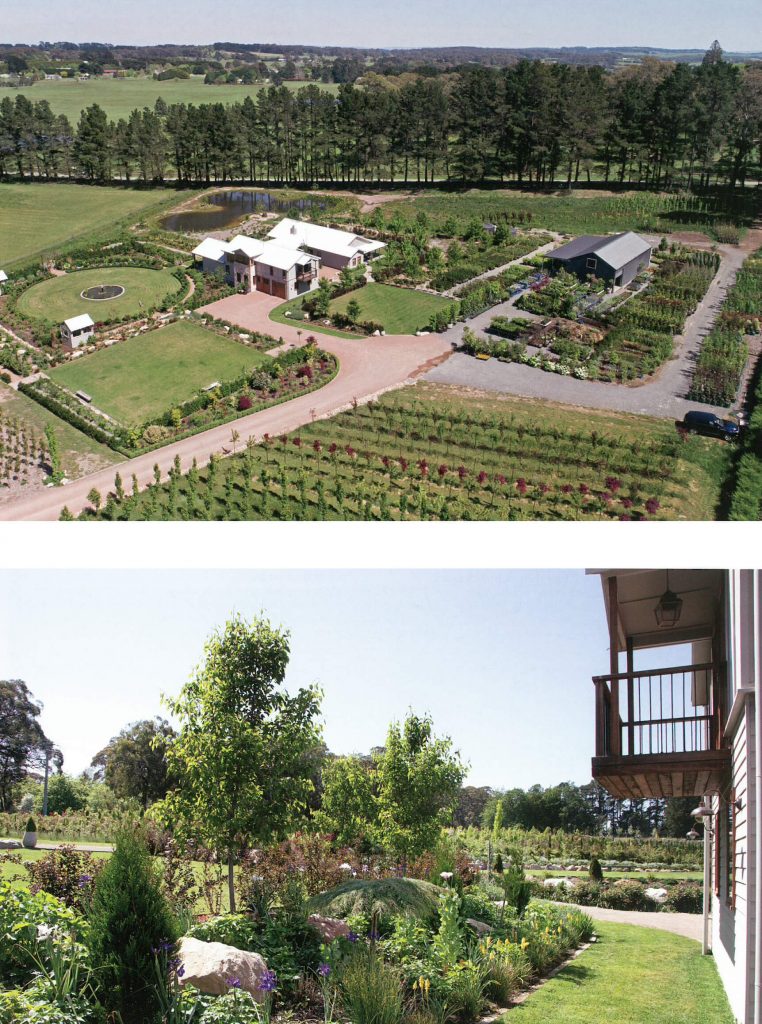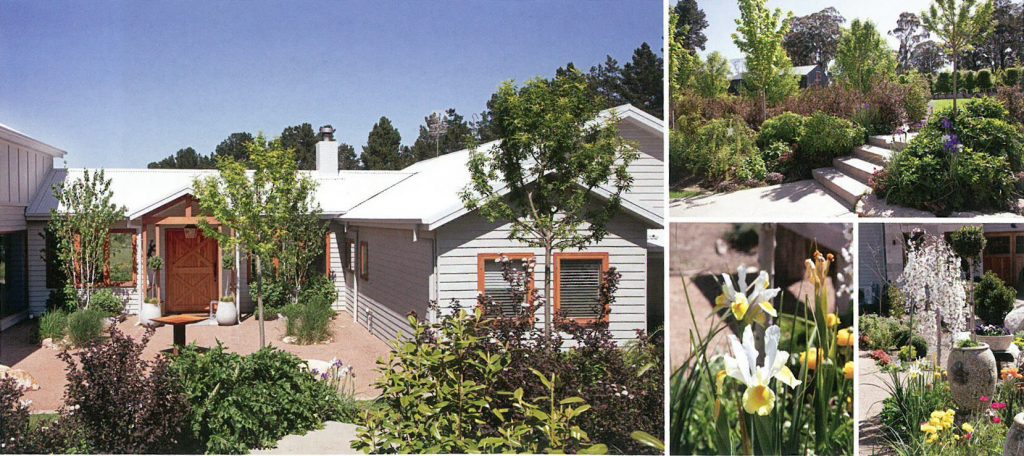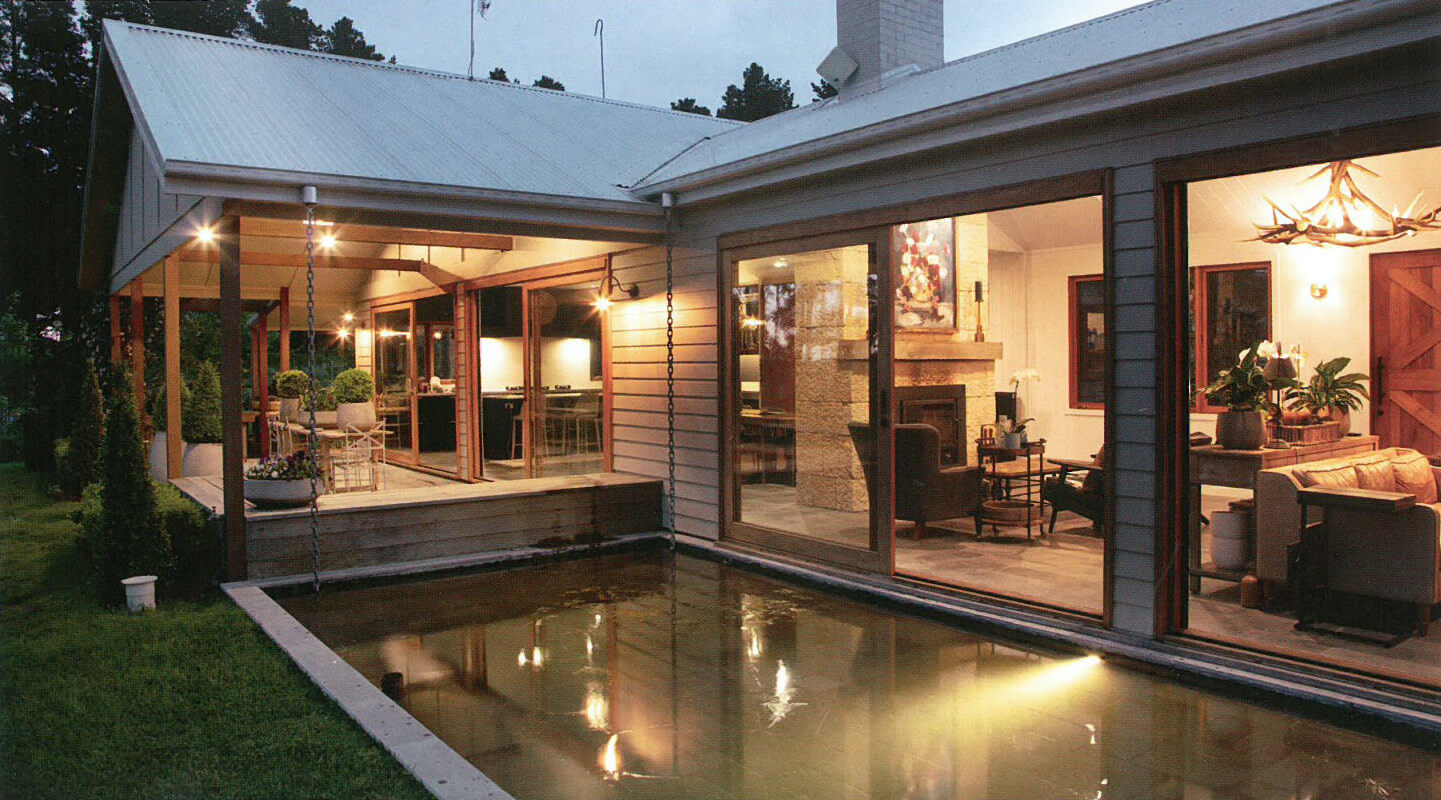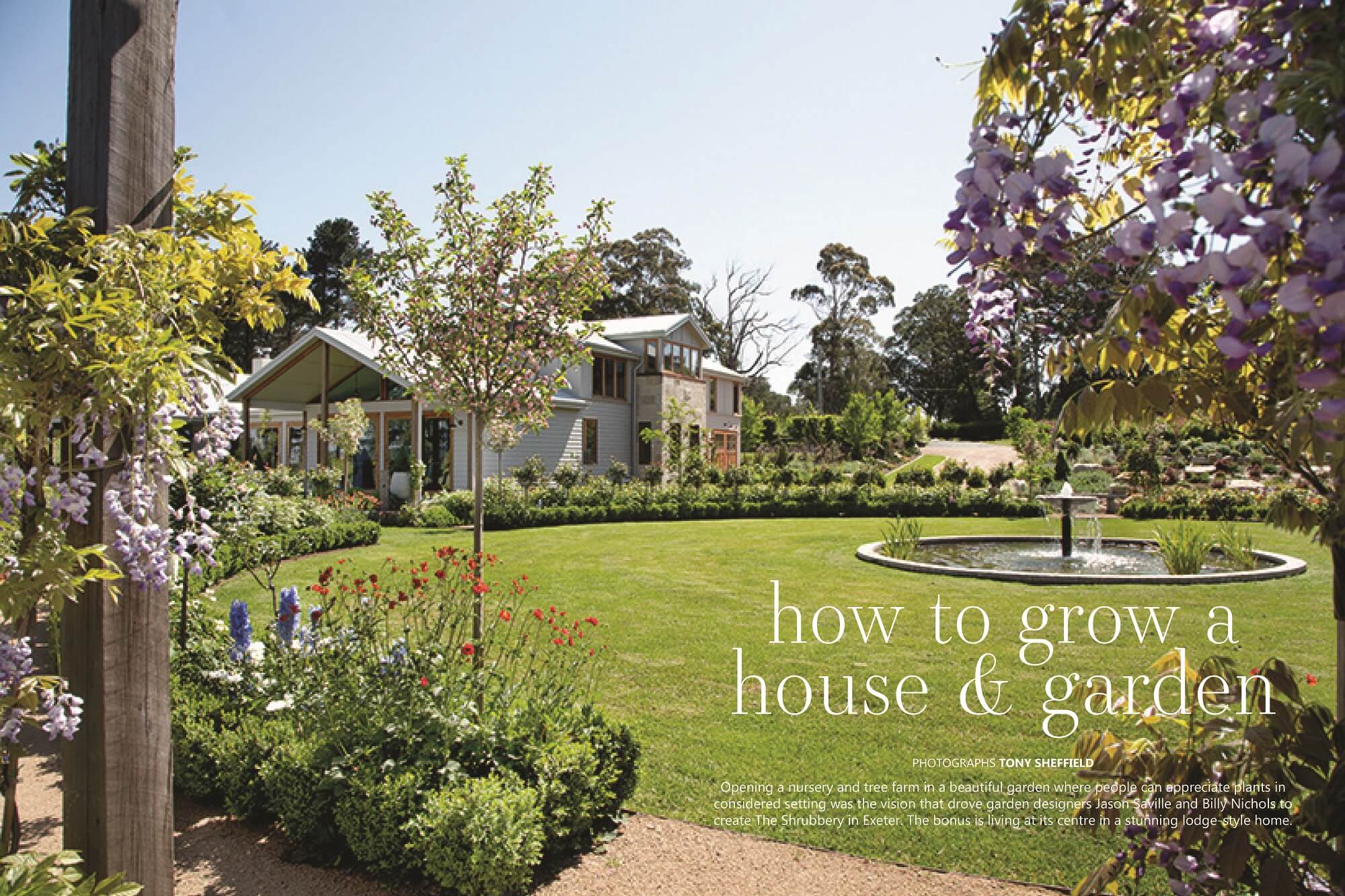
THE SHRUBBERY is a remarkably beautiful property, but even more remarkable is the speed of its creation. Owners Jason Saville and Billy Nichols first saw the Exeter site three years ago. Today, its 2.4 hectares boast a five-bedroom lodge-style house surrounded by flourishing gardens, a picturesque lake, a nursery and a tree farm with 10,000 trees. Back in January 2018, all they saw was a neat two-bedroom blue house in the centre of an entirely bare paddock. Jason and Billy bought it the next day – an audacious move considering they weren’t even looking to buy. “We came [from Byron Bay] to the Highlands
for a cool break because we’d been so busy,” says Billy. “We’d just bought a house in Byron Bay in town,” adds Jason, “and we’d moved in-we’d been there four weeks. But we moved here 14 days after buying it and in that 14 days we did all the design work for the house, the gardens and the trees.” This apparent impulse buy starts to make more sense, however, when Jason and Billy explain their motivation. They, are in fact, incredible planners who had long wanted to combine a garden design business with their own nursery and showpiece garden. That meant when they stumbled on the ideal location, they recognised it.
Jason’s background is in hospitality, in areas including interior design, commercial cookery and landscaping. For two decades he worked in the Blue Mountains on major hotels; most recently he designed and oversaw largescale landscaping at Parklands Country Garden and Lodges in Blackheath and Lilianfels in Katoomba. Jason grew up on 18 hectares in Horsley Park where his Maltese-Australian family farmed vegetables. As a teenager he’d be up at 2am to take produce to Flemington Markets. Gardening is in the blood, he says.
Billy grew up in England where his family had a large garden and he worked part-time in a garden centre. In 2014 he moved to the Gold Coast to study journalism at Southern Cross University and a year later he met Jason. “On weekends l’d help Jay with jobs, and l started learning from him, and when finished uni I started training in CAD (computer aided design).

“Working on a newspaper, every day you have to prove yourself again. With garden design, there’s an incredible sense of achievement because you get to see something progress and there’s a final product that you’ve created -and people get to enjoy it for a long period of time.” In 2017, Jason and Billy were planning to develop a property at Hawks Nest, north of Port Stephens. Jason says: “We have 35 acres (14 hectares) on the harbour and we were about to submit a DA for a super lodge there, but a [pre-submission] meeting didn’t go so well. Sol said to Billy, ‘Let’s go to the Highlands for a couple of days to get away’. We were staying at Craigieburn and saw Property Life magazine and this was on the cover. We called council and asked if we could we do a nursery, and we bought it the next day on the way home.” The concept, says Billy, was to make an interactive garden design experience. “In presenting designs to clients we’d always found, even with elevations and good rendering, that it can be hard fur them to imagine how a garden’s going to look, particularly with plants.” Jason has long been an admirer of famous nurseryman and landscape designer Paul Sorensen (1891-1983) and says the idea follows his philosophy. “He built a beautiful garden in Leura and he used to bring in all the seeds and grow conifers and shrubs that he could then show his clients. He’d take them through his garden and they’d say, ‘I like this one or that one’. So that’s why we did this.” Sorensen established his name in the Blue Mountains, most notably with Everglades in Leura, but in the early 1940s he had a second nursery in Berrima. In the late 1930s he designed the garden at lnvergowrie in Exeter, not far from The Shrubbery. “He knew the Highlands was a wonderful garden area,” says Jason. “You have to be in an area where people love their gardens to do something like this.”
THE HOUSE
The couple set to work immediately on both house and garden, project managing both. Having the existing house meant they could live in it while construction, landscaping and planting took place. The build was an extension and renovation, designed by Jason working with Blue Mountains architect Richard Starr, and plans were submitted to council within weeks. Bowral builders Shane and Billy Rofe of Rofebuild completed the build in December 2018. The owners knew exactly what they wanted and couldn’t love the home more. “Because we had lodges in mind [for Hawks Nest] that’s what we tried to do here,” says Jason. This meant big spaces, timber and stone, some colour for warmth, a pitched roof and “a Swiss chalet feel” upstairs. “We didn’t want a Hamptons-style house. We wanted a real masculine lodge feel. But I think while the architecture is quite masculine, the artwork is quite feminine, so it’s got a nice balance.” The home has a central kitchen/dining/living room, with a stone fireplace dividing the dining and lounge areas. The wing off the kitchen end (the original house) has two guest bedrooms, each with an en suite, and the mudroom. The wing off the lounge room end contains the master bedroom, en suite and a double garage, and upstairs, a spacious office, two more guest bedrooms and a bathroom. The floorplan is free flowing -you don’t pass a doorway walking from the kitchen through the lounge and up to the office. “You’re in amongst everything that happens all the time,” says Jason. “We opened the lounge with just the separation of a fireplace so everyone can hear one another and interact. We like to entertain that way.” Durability was another key element. The house is well lived in, with nursery staff eating lunch together inside, a family of Jack Russells trotting about, and clients walking through to the office.


Bluestone floor tiles are used inside and out for a cohesive “rustic farmhouse feel”, says Billy. Rosewood doors and windows, made by Mittagong’s Evalock, have been left raw. Jason says: “You just oil them once a year with a rag, it’s easy. It’s not like having to sand back paint every 10 years.” There are no curtains or blinds. Downstairs is painted Haymes Apollo Blue throughout, although the kitchen cabinetry is a midnight blue. It’s an entertainer’s kitchen with plenty of bench space (including integrated Pitt gas burners), a bar and butler’s pantry. But while the house is open, it’s also cosy in winter. The slow combustion fireplace doubles as the “engine” of the house, heating boilers in the roof that connect to radiators in most rooms. It runs 24/7 through winter and heats the whole house. The couple had the radiators powder-coated black in England to make them a feature. In summer, there’s air conditioning when needed, but more often they open the sliding glass doors and let the breeze blow across the reflection pool just off the lounge room. “It’s a bit of Byron,” says Billy. “Water’s important to us.” The master bedroom is their pride and joy. It’s huge, with picture windows facing west across the garden, and a side window framing a beautiful view of the house. “The master’s got to be king – that’s how we feel when we’re designing for other people too,” says Billy. “It’s about what you’re looking at every day and creating a special space for you.” The walk-through wardrobe and en suite are also on a generous scale, and everything has been chosen with thought, including washplane basins and smoked glass shower screens. Rustic touches blend with the slick, with reclaimed timber used on some door jambs and to frame artworks commissioned from Robertson artist Jeannie Dolan.
“We love using reclaimed things in houses or gardens,” says Billy. “As soon as you bring timber in, it doesn’t have to be just one feel – all rustic or all modern. Different finishes can tie together.” Another rustic choice was leaving the bluestone floor unsealed, except in the bathrooms. “We love the floors in 100 and 200 year old French farmhouses, so we decided we wanted that worn look,” says Billy. “After the first few cocktail parties, the floor aged beautifully.” Upstairs is the loft office, with desk space for Jason, Billy and nursery manager Michelle Harelle and sofas for presentations with clients. It’s cosy, with a pitched roof, but also open, with windows overlooking the garden. What do clients say when they walk in? “We came for a garden and now we want a house,” says Jason.
THE GARDEN
The most important part of the home’s design is how it relates to the garden. The two were designed together, so from every window there’s a beautiful view or cameo. There are also wide verandahs where they sit and enjoy the sunsets. “The gardens are all about the aspect from the house too,” says Billy. “For us, that is key when designing a garden -looking from the inside out.” Jason adds: “When we go to a client’s place, we ask to look through each of the windows. You don’t want to be looking out of the bedroom at a hedge.” They started cutting earth in April 2018, a major 12 week job. “The land is all sculpted,” says Jason, “and there are drainage pipes everywhere to collect water to run down to the lake, so it all falls perfectly. We spent the time because we don’t want channelling in the land.” They worked with Josh Turner of
Turners Southern Excavations, Bowral, and had a French carpenter, Quentin Keller, living with them for six months – he built the garden shed, glasshouse and rustic benches. Bowral horticulturist Colin Blanch helped them plant out the gardens. “We learned a lot about achieving successional planting in this area from him,” says Billy. Around the top half of the property, they planted about 10,000 trees of 120 varieties in a semicircular tree farm. Trees were grouped according to soil and aspect. “The good basalt is higher up and the ornamentals love it,” says Billy. vvv“Where it is a bit rockier and free draining is good for the conifers. The soil near the [existing] radiatas is a bit wetter and more acidic, which is good for the hornbeams and dogwoods.” They wanted to grow trees people can’t easily buy. “In Europe they have lots of pleached and shaped tree forms, and doing that here was a dream,” says Billy. “I’ve got a lot of hornbeams I’m making into columns and l’m topiarising conifers in designs that are hard to find.” Inside the semicircle are the gardens surrounding the house, all planted for the owners’ enjoyment but also to showcase plants and garden styles.

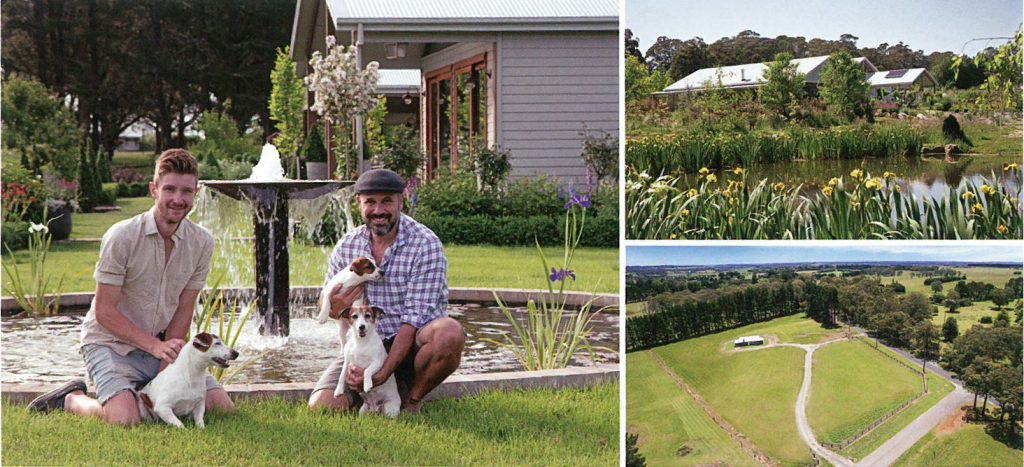
Anyone who visits the nursery can wander through the gardens, getting ideas for plants and design. The plan is to introduce an app that people can download so they can scan a QR code next to any plant that catches their eye. They will then be able to see if it’s available in the nursery. Most visitors start their walk at a square formal lawn surrounded by crab apples, liquorice plant, lavender, viburnum and shastas. A Portuguese laurel hedge-lined walk leads to a large circular formal garden with a fountain at its centre. The lawn is surrounded by mass planted perennials and roses, including Julia’s Roses’ as standards, underplanted with ‘Claire Austins’. “There are roses in flower for about nine months of the year,” says Jason. Other parts of the garden include a dry garden, a white garden, a potage garden and a rambling cottage garden. Eventually hedging and trees will grow so that most sections are slightly hidden from each other, allowing for a “garden with reveals”. A trefoil-shaped lake is the star feature, but doesn’t come into view until you walk around the house. “We love big areas and big impact,” says Jason. Eventually, birches will reflect on its surface and meadow planting will surround it. “You won’t be able to tell we made it.” They mention two other gardening philosophies: they plant so there’s always something flowering and something coming into flower; and they move anything that isn’t working. “Think of plants like furniture,” says Billy. “You can always put them in a different place and see if they work better; and we have good soil variants here.” They have had one big setback. The plan is to propagate much of what they sell, and they were well under way last summer, but then came the fires.

They had to evacuate and couldn’t water for four days and lost all their stock. “We lost a year and a half of work,” says Jason. “IL took a week for three of us to empty all of the pots.” They’ve since ordered in nursery stock, but in a year they will have their own stock to sell.
“This is all about giving people ideas,” says Billy. “Often when people look at a plant in a nursery, they can’t really envisage what it’s going to look like in their garden. Here, it’s almost like an interior store experience. When you go into Suzie Anderson [in Moss Vale] and see a lounge, you see it in a lounge
Setting and can imagine how it’s going to look in your house.”
“We’re like the Suzie Anderson of gardens,” continues Jason with a laugh. “We’re trying to show people how plants could look in their garden.”
They understand many people don’t have a designer’s mind – few could have imagined how The Shrubbery might look on that first day in an almost empty paddock. But most people appreciate a thriving garden once they see it. Now everyone can appreciate the results of their vision.

